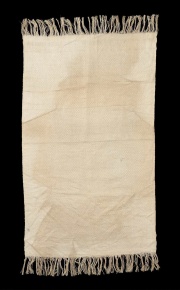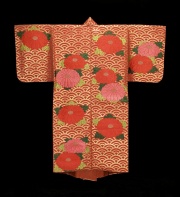Difference between revisions of "Twill weave"
Jump to navigation
Jump to search
| (4 intermediate revisions by the same user not shown) | |||
| Line 1: | Line 1: | ||
| − | [[File:49.454-SC45253.jpg|thumb| | + | [[File:49.454-SC45253.jpg|thumb|Linen twill weave towel<br>MFA #: 49.454]] |
== Description == | == Description == | ||
| − | A basic weave pattern that results in parallel, diagonal ribs. Twill weaves are made by weaving the filling threads over two or more warp yarns then under one yarn. This produces a strong durable fabric. The pattern can be either left-handed (upper left to lower right) or right-handed (lower left to upper right). Herringbone is a common variation in which the twill direction is reversed at regular intervals. Twill weave fabric were popularly used as painting canvases by 18th and 19th century artists (Mayer 1969). Examples of commonly twill weave fabrics are: [[gabardine|gabardine]], [[serge|serge]], [[drill (textile) |Drill]], [[denim|denim]], [[surah|surah]], [[broadcloth|broadcloth]], [[sharkskin|sharkskin]] cloth, and some [[tweed|Tweeds]]. | + | A basic weave pattern that results in parallel, diagonal ribs. Twill weaves are made by weaving the filling threads over two or more warp yarns then under one yarn. This produces a strong durable fabric. The pattern can be either left-handed (upper left to lower right) or right-handed (lower left to upper right). Herringbone is a common variation in which the twill direction is reversed at regular intervals. Twill weave fabric were popularly used as painting canvases by 18th and 19th century artists (Mayer 1969). Examples of commonly twill weave fabrics are: [[gabardine|gabardine]], [[serge|serge]], [[drill (textile) |Drill]], [[denim|denim]], [[surah|surah]], wool [[broadcloth|broadcloth]], [[sharkskin|sharkskin]] cloth, and some [[tweed|Tweeds]]. |
| − | [[File:21.161-SC16733.jpg|thumb| | + | [[File:21.161-SC16733.jpg|thumb|Silk twill weave costume<br>MFA # 21.161]] |
== Synonyms and Related Terms == | == Synonyms and Related Terms == | ||
| Line 12: | Line 12: | ||
<gallery> | <gallery> | ||
| − | File:2x2twillweave_Indn.cashm.shawl.jpg|Twill | + | File:2x2twillweave_Indn.cashm.shawl.jpg|Twill from cashmere shawl |
| + | File:MFA20182313 Gabardine.jpg|Gabardine riding habit<br>MFA# 2018.2313 | ||
| + | File:MFA431120 Serge.jpg|Serge drawstring bag<br>MFA# 43.1120 | ||
| + | File:MFA5391 Surah.jpg|Surah dress<br>MFA# 53.91 | ||
</gallery> | </gallery> | ||
Latest revision as of 14:03, 23 October 2020
Description
A basic weave pattern that results in parallel, diagonal ribs. Twill weaves are made by weaving the filling threads over two or more warp yarns then under one yarn. This produces a strong durable fabric. The pattern can be either left-handed (upper left to lower right) or right-handed (lower left to upper right). Herringbone is a common variation in which the twill direction is reversed at regular intervals. Twill weave fabric were popularly used as painting canvases by 18th and 19th century artists (Mayer 1969). Examples of commonly twill weave fabrics are: Gabardine, Serge, Drill, Denim, Surah, wool Broadcloth, Sharkskin cloth, and some Tweeds.
Synonyms and Related Terms
herringbone weave; ligamento de sarga (Esp.)
Additional Images
Resources and Citations
- M. Joseph, Introductory Textile Science, Holt Reinhold & Winston, Fort Worth, 1986. ° R. Mayer, A Dictionary of Art Terms and Techniques, Harper and Row, New York, 1969.
- Hoechst Celanese Corporation, Dictionary of Fiber & Textile Technology (older version called Man-made Fiber and Textile Dictionary, 1965), Hoechst Celanese Corporation, Charlotte NC, 1990
- Rosalie Rosso King, Textile Identification, Conservation, and Preservation, Noyes Publications, Park Ridge, NJ, 1985
- Website: www.fabrics.net
- R. J. Gettens, G.L. Stout, Painting Materials, A Short Encyclopaedia, Dover Publications, New York, 1966
- G.S.Brady, Materials Handbook, McGraw-Hill Book Co., New York, 1971 Comment: p. 248
- Ralph Mayer, A Dictionary of Art Terms and Techniques, Harper and Row Publishers, New York, 1969 (also 1945 printing)
- Hermann Kuhn, Conservation and Restoration of Works of Art and Antiquities, Butterworths, London, 1986
- Edward Reich, Carlton J. Siegler, Consumer Goods: How to Know and Use Them, American Book Company, New York City, 1937
- Random House, Webster's Encyclopedic Unabridged Dictionary of the English Language, Grammercy Book, New York, 1997
- The American Heritage Dictionary or Encarta, via Microsoft Bookshelf 98, Microsoft Corp., 1998
- Art and Architecture Thesaurus Online, http://www.getty.edu/research/tools/vocabulary/aat/, J. Paul Getty Trust, Los Angeles, 2000





